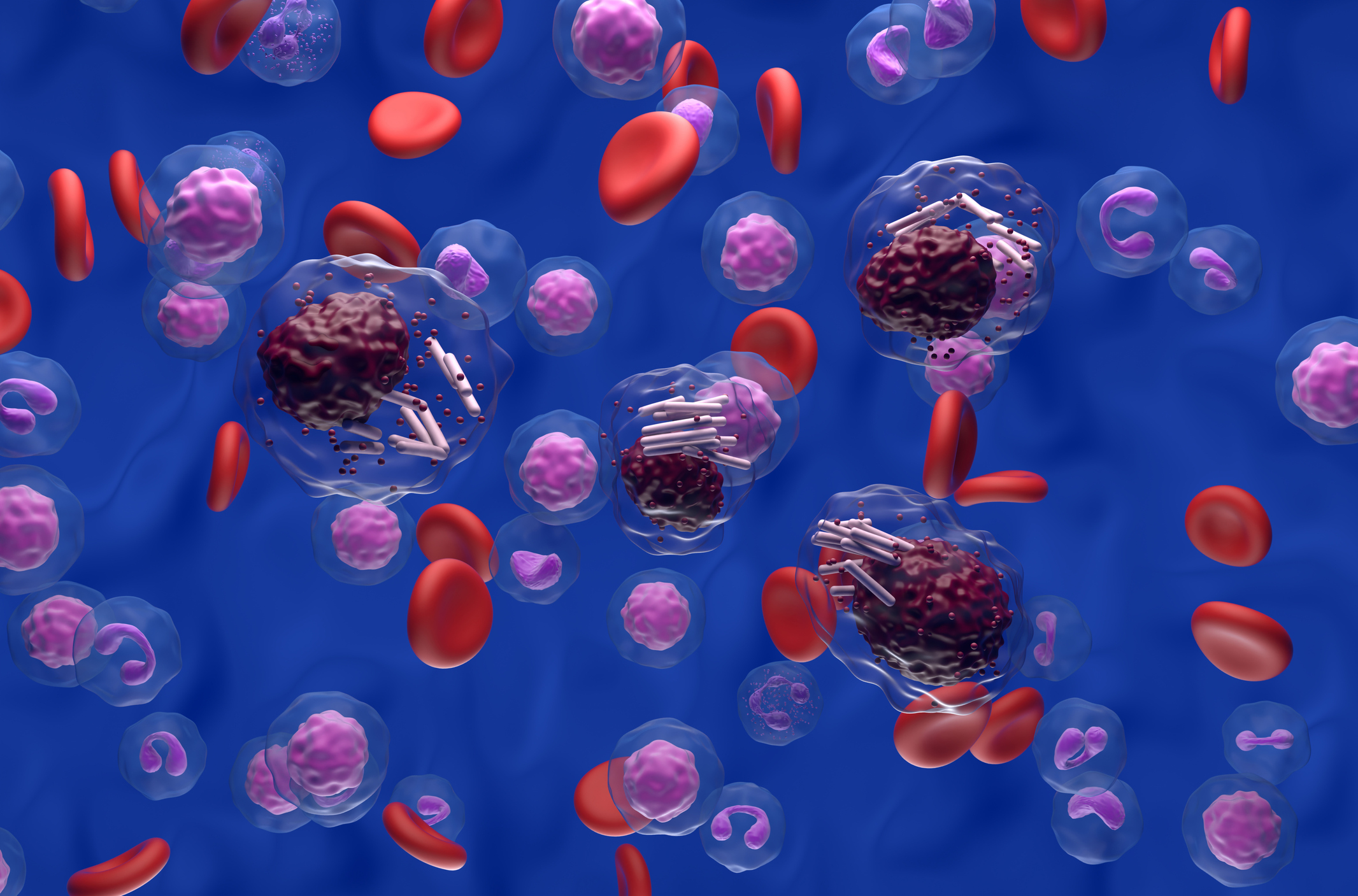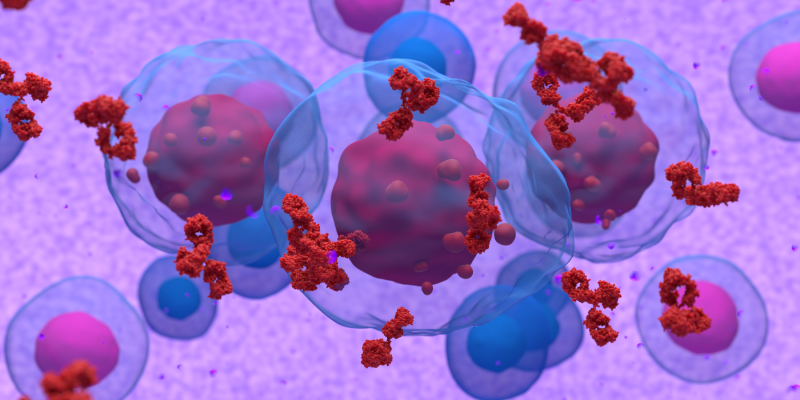
In recent years, trials such as CAPTIVATE and AMPLIFY have evaluated Bruton tyrosine kinase inhibitor (BTKi) and B-cell lymphoma-2 inhibitor (BCL-2i) combinations for the treatment of chronic lymphocytic leukemia (CLL). Kerry Rogers, MD, associate professor in the Division of Hematology at The Ohio State University, presented on novel agents and combination strategies in CLL at the Fourth Annual National General Medical Oncology Summit February 28 to March 2, 2025.
BTKi/BCL2i Combinations
Dr. Rogers believes that BTKi/BCL-2i combinations should be increasingly utilized in the treatment of CLL due to their high efficacy, durable responses, and ability to reduce the risk of molecular resistance.
“These combinations may change how treatment is offered over a patient’s lifespan,” she told Blood Cancers Today. “As CLL is not currently curable, patients can anticipate receiving multiple treatments. In clinical trials with BTKi/BCL-2i combinations that have longer follow-ups than AMPLIFY, we have seen that both classes of drugs can be reused at time of next treatment. While there is still a lot to learn about sequencing of therapies in CLL, avoiding resistance to targeted agents is expected to be beneficial.”
Ibrutinib Plus Venetoclax With and Without Anti-CD20 Antibodies
In the phase 2 CAPTIVATE study, a fixed-duration cohort of patients received 15 total cycles of treatment: 3 cycles of ibrutinib and 12 subsequent cycles of ibrutinib plus venetoclax. Dr. Rogers noted differences in progression-free survival (PFS) by risk group. Patients with unmutated IGHV had a shorter 5-year PFS than those with mutated IGHV (56% vs 80%, respectively), and patients with high-risk features such as del(17p), TP53 mutations, and/or complex karyotype had a shorter PFS than those without high-risk features (54% vs 77%, respectively).1
The phase 2 IVO study combined ibrutinib, venetoclax, and obinutuzumab in 3 cohorts of patients with treatment-naive and relapsed or refractory CLL. The PFS was 7.4 years in the treatment-naive cohort, compared with 6.5 years with just venetoclax and obinutuzumab and 9 years with continuous ibrutinib.1 However, when the phase 3 A041702 trial randomized older adult patients to ibrutinib, venetoclax, and obinutuzumab, ibrutinib and obinutuzumab, or continuous ibrutinib, the hazard ratio was similar in each arm, showing that the 3-drug combination was not superior in terms of PFS. A similarly designed trial with young patients is ongoing.1
AMPLIFY Trial
The phase 3 AMPLIFY trial evaluated fixed-duration acalabrutinib and venetoclax with or without obinutuzumab versus investigator’s choice of fludarabine-cyclophosphamide-rituximab (FCR) or bendamustine-rituximab (BR) as first-line therapy for fit patients with CLL. Both acalabrutinib and venetoclax with obinutuzumab (AVO) or without obinutuzumab (AV) had improved PFS compared with FCR/BR (not reached vs 47.6 months, respectively).2
“My hope is that now AV and AVO are added to the NCCN [National Comprehensive Cancer Network] Guidelines, they will be offered to patients as a standard-of-care option,” Dr. Rogers told Blood Cancers Today. “These regimens have great outcomes, and AVs offer a fixed-duration option with all oral agents and fewer required visits compared to venetoclax and obinutuzumab. This makes it more convenient and potentially more appropriate for some patients.”
The results of the AMPLIFY trial were also broken down by IGHV status, and the benefit of obinutuzamab was shown to be greatest in IGHV-unmutated CLL.1 “For AVO, the IGHV-mutated and unmutated CLL patient PFS is overlapping, showing that when you add obinutuzamab in, you make the outcomes equal between IGHV-mutated and unmutated CLL patients,” said Dr. Rogers in her presentation. “The obinutuzamab doesn’t add much for IGHV-mutated patients. This did not include del(17p). The majority of benefit to the O [obinutuzumab] is in IGHV-unmutated CLL.”
However, obinutuzamab does increase toxicity and infection risks, Dr. Rogers noted. “AV had the fewest COVID deaths at 10, with both antibody-containing arms having either 25 or 21,” she said. “This is highlighting that this is a very real risk of adding an antibody here. While certainly I wouldn’t expect this many COVID deaths at the current timeframe, this means that obinutuzamab adds some risk that we have to consider carefully when we’re looking at the benefit.”
Undetectable measurable residual disease (MRD) was evaluated as a secondary end point in the AMPLIFY trial. At the end of treatment, the undetectable MRD rates were 95.0% for AVO, 45.0% for AV, and 72.9% for FCR/BR.1 Despite showing lower rates of undetectable MRD, AV had a longer PFS compared with FCR/BR, Dr. Rogers noted. These results may warrant further investigation into the prognostic value of MRD in CLL.
“I think we are still working on defining the role of MRD in CLL treatment, and it likely means different things with different treatments,” Dr. Rogers told Blood Cancers Today. “It is true that even with lower rates of MRD undetectable status, AV had a longer PFS compared to the chemoimmunotherapy arm (FCR/BR). However, within each arm, patients who had undetectable MRD appeared to have a longer PFS compared to those who had detectable disease. This means that for patients who were treated with AV, patients who had undetectable MRD appeared to have a longer PFS than those where MRD was still detected. So, MRD status is helpful within treatment arms, but its use in understanding outcomes between very different types of treatments (eg, chemotherapy vs targeted agents) is probably limited.”
Other BTKi Venetoclax Combinations
Next in her presentation, Dr. Rogers discussed other BTKi combinations with venetoclax. In arm D of the SEQUOIA trial, zanubrutinib plus venetoclax yielded a 12- and 24-month PFS of 95% and 94%, respectively, in patients with del(17p) CLL or SLL.1
A phase 1/1b trial (BGB-11417-101) looked at zanubrutinib (320 mg) combined with sonrotoclax, a novel BCL2i, at 2 dose levels (160 mg and 320 mg). By week 48, sonrotoclax 160 mg achieved a complete response (CR) rate of 60% and a partial response (PR) rate of 40%, and sonrotoclax 320 mg achieved a CR rate of 58% and a PR rate of 42%.1 The combination is now being compared with venetoclax plus obinutuzumab in the phase 3 CELESTIAL-TNCLL trial. “I’m really looking forward to this and hope that it gives us another BTK inhibitor/BCL-2 inhibitor combination,” Dr. Rogers said during her presentation.
Novel Agents
The phase 1 BRUIN CLL-321 trial compared pirtobrutinib with idelalisib plus rituximab (IdelaR) or bendamustine plus rituximab (BR) in covalent BTKi-pretreated CLL or SLL. The median PFS was improved with pirtobrutinib compared with the standard arm, but the overall survival was similar between the arms. “This is showing that this is not the benefit we need for a lot of our CLL patients,” said Dr. Rogers.1
Dr. Rogers also presented updated follow-up data from the TRANSCEND CLL 004 trial of lisocabtagene maraleucel in relapsed or refractory CLL. “Complete remission or complete remission with incomplete marrow recovery is really what the patients need to be able to get a very durable remission,” she explained.1 For the 20% of patients who achieved a CR, the duration of response was not reached. The toxicities were manageable, with a high rate of cytokine release syndrome, albeit low grade.1
A cohort of the TRANSCEND CLL 004 trial was treated with ibrutinib before collection, through lymphodepletion, and after cell infusion. About twice as many patients (45%) achieved a CR, expecting to achieve durable remission.1
Looking Ahead
Phase 3 trials are under way to evaluate pirtobrutinib as monotherapy and in combination with other agents such as ibrutinib, bendamustine plus rituximab, or venetoclax plus rituximab, as well as in earlier lines of therapy.1
Dr. Rogers described what she hopes to see for the future regarding BTKi/BCL-2i combinations and novel agents. “These combinations offer another important option for CLL patients and are in keeping with what the field has done to make CLL treatment not only more effective, but also safer and more feasible for more patients,” she told Blood Cancers Today. “The addition of BTKi/BCL-2i regimens allow for more options so that each individual can receive the CLL therapy that is best for them.”
References
- Rogers, K. Module 3: novel agents and combination strategies. Presented at: Fourth Annual National General Medical Oncology Summit; February 28-March 2, 2025; Miami, Florida.
- Brown JR, Seymour JF, Jurczak W, et al. Fixed-duration acalabrutinib plus venetoclax with or without obinutuzumab versus chemoimmunotherapy for first-line treatment of chronic lymphocytic leukemia: interim analysis of the multicenter, open-label, randomized, phase 3 AMPLIFY trial. 2024;144(suppl1):1009. doi.org/10.1182/blood-2024-200701






 © 2025 Mashup Media, LLC, a Formedics Property. All Rights Reserved.
© 2025 Mashup Media, LLC, a Formedics Property. All Rights Reserved.